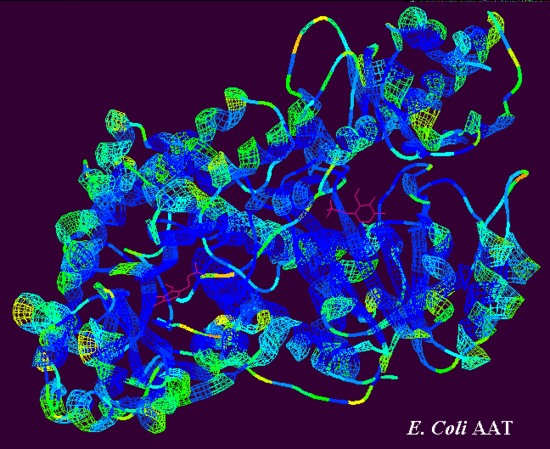Vitamin B6 Dependent Enzymes
- Page ID
- 493
Callstack:
at (Workbench/LarsenLab/Research/PhotoBiology/Enzymatic_Activity/Vitamine_B6_Dependent_Enzymes), /content/body/pre, line 1, column 1
While many biological functions, such as photosynthesis or photoreceptors, are intrinsically light activated, most enzymes in nature do not require photons to function. Even included in this category are systems that contain chromophoric cofactors, such as the vitamin B6-dependent enzymes containing the pyridoxal 5’-phosphate (PLP) cofactor that has been identified in over 4% of known enzymes. We demonstrate here that the application of blue wavelength light can actually enhance enzymatic activity for the PLP-dependent enzyme aspartate aminotransferase (AAT) with the aspartate substrate by up to 50% over standard “dark adapted” kinetic assays. We further demonstrate that in intentionally “broken” enzymes, due to extreme pH or directed mutagenesis, the enzymatic activity can be “healed” by photoexcitation to operating efficiencies similar to native conditions.
These observations can be understood by exploring the photo-induced changes in the AAT and in isolated PLP systems with time-resolved techniques. We present here, dynamical “transient absorption” measurements on these systems identifying kinetic features extending over 17 orders in magnitude in time from fs (10-15 s) to minutes. Excitation of the isolated PLP cofactor and PLP bound to the aspartate substrate as a Schiff base in solution with blue light leads to ultrafast (1 ns) production of a photo-induced intermediate, which is ascribed to the triplet state via ?s quenching with heavy atoms. This triplet state acts as a “reactive intermediate” that breaks a weak C-H single bond in the Schiff base to form the essential “quininoid” intermediate that is responsible for most enzymatic mechanisms identified for PLP-dependent enzyme activity. Since the formation of the quininoid is the rate determining step in these mechanisms, photoexcitation effectively short-circuits the natural existing barriers for enzymatic activity resulting in astoundingly enhanced efficiencies. By contrasting light- activated kinetics with thermally-activated kinetics via time-resolved spectroscopies, critical aspects in enzymology protein function can resolved, for example, by photogenerating species that avoid or surmount activation barriers that are normally overcome thermally.
systems with time-resolved techniques. We present here, dynamical “transient absorption” measurements on these systems identifying kinetic features extending over 17 orders in magnitude in time from fs (10-15 s) to minutes. Excitation of the isolated PLP cofactor and PLP bound to the aspartate substrate as a Schiff base in solution with blue light leads to ultrafast (1 ns) production of a photo-induced intermediate, which is ascribed to the triplet state via ?s quenching with heavy atoms. This triplet state acts as a “reactive intermediate” that breaks a weak C-H single bond in the Schiff base to form the essential “quininoid” intermediate that is responsible for most enzymatic mechanisms identified for PLP-dependent enzyme activity. Since the formation of the quininoid is the rate determining step in these mechanisms, photoexcitation effectively short-circuits the natural existing barriers for enzymatic activity resulting in astoundingly enhanced efficiencies. By contrasting light- activated kinetics with thermally-activated kinetics via time-resolved spectroscopies, critical aspects in enzymology protein function can resolved, for example, by photogenerating species that avoid or surmount activation barriers that are normally overcome thermally.
The enhancement of enzymatic activity increases as light intensity increased until a threshold is reached thereby increasing light results in poorer enhancement until eventually suppression is observed. Under these strong light conditions (~3W), the photophysics can be rationalized via the generation of non-photoactive populations (potentially radicals). Applications of similar studies to other PLP-dependent enzymes with differing biological function including racemases and decarboxylases will be discussed.

